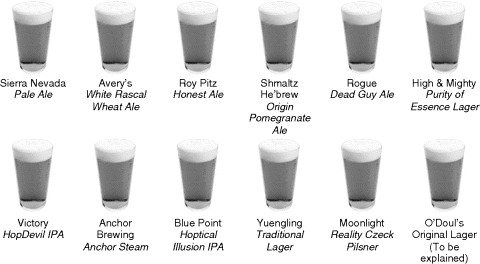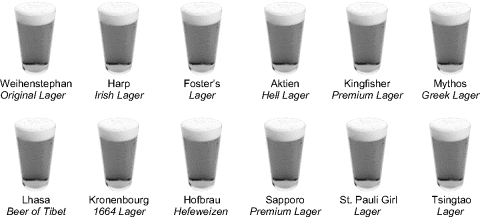This edition first published 2011
2011 Matt Lawrence
Blackwell Publishing was acquired by John Wiley & Sons in February 2007. Blackwell's publishing program has been merged with Wiley's global Scientific, Technical, and Medical business to form Wiley-Blackwell.
Registered Office
John Wiley & Sons Ltd, The Atrium, Southern Gate, Chichester, West Sussex, PO19 8SQ, United Kingdom
Editorial Offices
350 Main Street, Malden, MA 02148-5020, USA
9600 Garsington Road, Oxford, OX4 2DQ, UK
The Atrium, Southern Gate, Chichester, West Sussex, PO19 8SQ, UK
For details of our global editorial offices, for customer services, and for information about how to apply for permission to reuse the copyright material in this book please see our website at www.wiley.com/wiley-blackwell .
The right of Matt Lawrence to be identified as the author of this work has been asserted in accordance with the UK Copyright, Designs and Patents Act 1988.
All rights reserved.Nopart of this publication maybe reproduced, stored in a retrieval system, or transmitted, in any form or by any means, electronic, mechanical, photocopying, recording or otherwise, except as permitted by the UK Copyright, Designs and Patents Act 1988, without the prior permission of the publisher.
Wiley also publishes its books in a variety of electronic formats. Some content that appears in print may not be available in electronic books.
Designations used by companies to distinguish their products are often claimed as trademarks. All brand names and product names used in this book are trade names, service marks, trademarks or registered trademarks of their respective owners. The publisher is not associated with any product or vendor mentioned in this book. This publication is designed to provide accurate and authoritative information in regard to the subject matter covered. It is sold on the understanding that the publisher is not engaged in rendering professional services. If professional advice or other expert assistance is required, the services of a competent professional should be sought.
Library of Congress Cataloging-in-Publication Data is available on request.
ISBN 978-1-4443-3640-5
A catalogue record for this book is available from the British Library.
This book is published in the following electronic formats: eBook 9781444397000; ePub 9781444397017
To anyone who has ever lifted a pint in philosophical contemplation, and to the brewers who make it possible.
Preface
A funny thing happened on the way to the monastery
I was driving down the southern California coast on my way to a meditation retreat, and thinking about the book of philosophical puzzles that I had been writing. My editor was enthusiastic about the project, but I still wasn't set on a title. Since it was a book of very short philosophical puzzles designed to whet the reader's appetite for philosophy, I tried to brainstorm titles based around small things, quick things, short things, wet things. Five-Minute Philosophical Puzzles? Bite-Sized Philosophical Puzzles? Forty-Eight Quick Conundrums? Obviously, I had to keep thinking. And then, out of nowhere, it hit me: Pint-Sized Philosophical Puzzles! After all, what goes better with a philosophical puzzle than a pint of good beer? And who loves philosophical puzzles more than beer drinkers? Like beer and football, or beer and pizza, beer and philosophy is a match ordained by the gods. One never knows quite how or why inspiration strikes, but, in retrospect, I realize that the idea came to me when I was just a couple of miles downwind of the Stone Brewery in Escondido, California. Surely the smell of fresh hops must have breezed through my open window. In any case, Philosophy on Tap was born the first book ever to pair 48 great beers (two full cases) with 48 philosophical puzzles.
The basic idea of the book is to explain and examine each philosophical conundrum in no more time than it takes to drink the pint that accompanies it, and each pint has been selected expressly for its particular puzzle. For example, Zeno's Paradox is the oldest puzzle in the book from the Western philosophical tradition, so I've paired it with a beer from the oldest brewery in the Western world, Weihenstephan Original Lager. Plato's Myth of Gyges has been paired with a Greek lager that is quite appropriately called Mythos. And what would go better with the Beer Goggles Paradox than a Horn Dog Barleywine from the Flying Dog Brewery? In this manner you can explore 48 puzzles over 48 pints preferably not all in one night. By the end of the book you'll be well versed in philosophy and in the great beers of the world.
About the Puzzles
In choosing the puzzles for the book, I have tried to cover the most central and perplexing questions of philosophy. Most are what can be fittingly called life's biggest questions, but several were included because of their relevance to the beer-loving philosopher. Untangling Taste is a good example here, as is The Case for Temperance. My aim throughout the book has been to set up the puzzles rather than to solve them. After all, half the fun of philosophy is to figure things out for oneself. So while I often suggest some possible solutions or relevant points to consider, the reader is generally left to reach his or her own conclusion, or, better still, to discuss it with friends at the pub.
About the Truth
You should be warned that I follow the well-established pub tradition of embellishing my stories. Occasionally I'll stretch the truth, and once in a while I'll tell a bald-faced lie. Of course this is all for your reading (and drinking) enjoyment. If you have a penchant for the truth, I suggest that you look for the Truth be told section that follows some of the puzzles. If there was a lie or pub-stretch somewhere in the puzzle, it is there that I will set the record straight.
About the Beer
In choosing the 48 beers that would become the pints of the puzzles, my primary aim was to find beers that fit the particular puzzles in interesting or amusing ways. As you'll soon see, there are all sorts of ways that beer and philosophy intersect. Another key concern was quality. I have tried to avoid bad beers though this can be a bit of a gray area given that people's tastes differ. Generally you'll find that the majority of the beers that I've included are award-winning brews that stand among the very best in the world. But because they cover a wide range of styles, it is doubtful that you will be crazy about them all. Yet anyone who drinks all 48 will be sure to encounter a number of their old favorites and to discover many new ones. Since we've got two full cases to work with, we can break them down into four 12-packs.
American craft beers (lighter brews)
American craft beers (darker/stronger brews)
Beers of the world (lighter brews)
Beers of the world (darker/stronger brews)

As you might imagine, some of the amber beers and strong ales resist classification in terms of simply light or dark, so please don't take their designation here too seriously. But I hope you'll appreciate the fact that I've tried to give you a rather balanced beer drinking experience through a wide range of beer styles from a number of different countries. Since half of them are American brews, only an American could find this assortment to be geographically balanced by any stretch of the imagination. But since American craft brewing has undergone such a revolution over the past 20 years, and has produced so many great and interesting beers, I hope you'll enjoy their prevalence nonetheless. I've also tried to create a balance between well-known beers and the more esoteric beers. Some of the latter may be tricky to find. Searching them out might strike you as a worthy and challenging quest perhaps something to put on your bucket-list (beers to drink before you kick the bucket). But if you'd like to minimize the search, I've arranged several Philosophy on Tap beer packages with Hi-Time Cellars. They have one of the largest selections of bottled beer on the planet, and can ship them to your doorstep. You can order online at www.hitimewine.net/ . Just select the tab for beer and search alphabetically for Philosophy on Tap. At the end of each puzzle, you'll also find a space for your tasting notes, so that you can keep track of your new-found favorites. You can also visually document the flavors using the spider-web graph. Mark low-flavor values closest to the center, and high-flavor values toward the outside. The sample shown here is from a Belgian Dark Ale.















